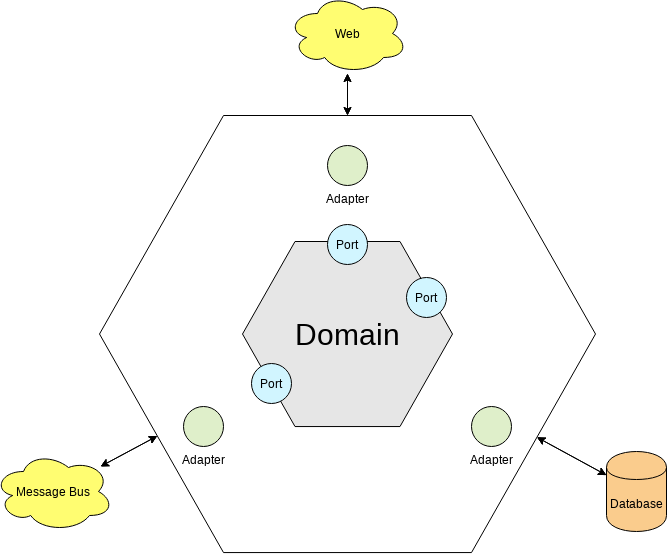Diagram arsitektur heksagonal adalah pola arsitektur yang digunakan dalam desain perangkat lunak yang bertujuan untuk menciptakan komponen aplikasi yang terpisah dengan longgar. Pendekatan ini merupakan alternatif dari arsitektur berlapis tradisional. Ini adalah salah satu dari banyak bentuk DDD (Arsitektur Berbasis Domain).
Arsitektur heksagonal ditemukan oleh Alistair Cockburn pada tahun 2005 dalam upaya untuk menghindari jebakan struktural yang diketahui dalam desain perangkat lunak berorientasi objek, seperti ketergantungan yang tidak diinginkan antara lapisan dan kontaminasi kode antarmuka pengguna dengan logika bisnis. Ide di baliknya adalah menempatkan input dan output di tepi desain. Dengan melakukan hal ini, Anda dapat mengisolasi logika pusat (inti) aplikasi Anda dari masalah eksternal. Input dan output di tepi berarti Anda dapat menukar penanganannya tanpa mengubah kode inti.

Seperti yang ditunjukkan pada gambar di atas, sebuah aplikasi dapat dianggap sebagai keseluruhan yang dilihat sebagai heksagon, dengan domain bisnis terletak di dalamnya. Aplikasi membuka port tertentu untuk membangun saluran komunikasi ke dan dari kode aplikasi. Ini mengisolasi logika domain dari infrastruktur, seperti basis data, bus pesan, pengiriman email, dan/atau server web. Ini dapat diperluas untuk mendukung berbagai jenis klien dengan mudah. Cukup tambahkan adaptor baru ke dalamnya. Dengan demikian, arsitektur heksagonal adalah kecocokan alami untuk Desain Berbasis Domain (DDD).
Dengan demikian, arsitektur heksagonal membagi sistem menjadi beberapa komponen yang dapat dipertukarkan dengan longgar melalui port dan adaptor yang diekspos, dan setiap komponen terhubung satu sama lain melalui port ini mengikuti protokol tertentu tergantung pada tujuan mereka. Ini membuat komponen dapat dipertukarkan pada tingkat mana pun dan memfasilitasi otomatisasi pengujian.
Inti
- Tempat Di Mana Logika Bisnis Aplikasi Terjadi Didefinisikan
- Ini Menerima Data, Melakukan Operasi Di Atasnya, Dan Opsional Dapat Berkomunikasi Dengan Pihak Eksternal Lain Seperti Basis Data Atau Entitas Persistensi.
Port
- Ini Mewakili Batasan Aplikasi.
Adaptor
- Ini Dapat Diimplementasikan Sebagai Antarmuka Untuk Digunakan Oleh Pihak Luar.
Alat Diagram Arsitektur Heksagonal Daring
Anda dapat menggambar Diagram Arsitektur Heksagonal dengan Visual Paradigm daring, dengan alat Diagram Arsitektur Heksagonal daring yang mudah digunakan

Buat Diagram Arsitektur Heksagonal
Buat Diagram Arsitektur Heksagonal daring
Diagram Arsitektur Heksagonal adalah representasi visual dari arsitektur heksagonal. Ini bertujuan untuk menciptakan komponen aplikasi yang terpisah dengan longgar yang dapat dengan mudah terhubung ke lingkungan perangkat lunak mereka melalui port dan adaptor. Ini membuat komponen dapat dipertukarkan pada tingkat mana pun dan memfasilitasi otomatisasi pengujian.
Diagram Daring VP dilengkapi dengan sejumlah template diagram arsitektur heksagonal. Anda dapat memulai dari template atau membuat sendiri dari awal. Berikut adalah beberapa template ini. Cukup klik tombol Edit untuk memulai.



This post is also available in Deutsch, English, Español, فارسی, Français, 日本語, Polski, Portuguese, Ру́сский, Việt Nam, 简体中文 and 繁體中文.













